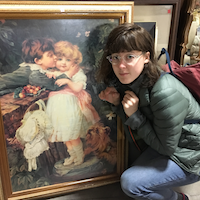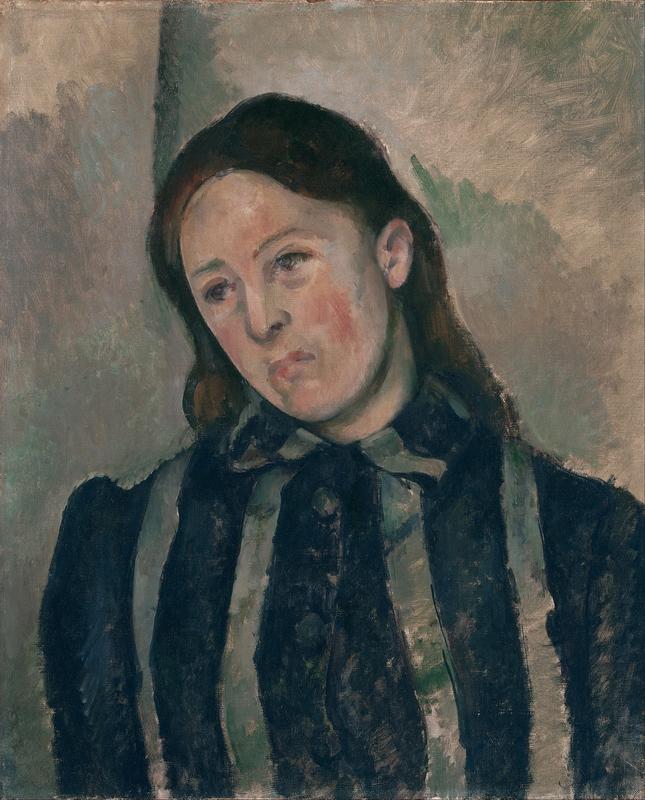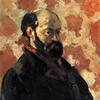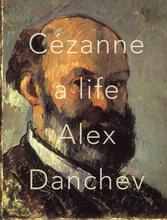More about Portrait of Madame Cézanne
- All
- Info
- Shop

Contributor
Hortense Piquet—the subject in Portrait of Madame Cézanne—was the only person that Cezanne liked to paint more than himself.
So often in history, an artist’s relationship with their “muse” is one of fiery passion and inspiration; Picasso, for instance, swapped one woman for a new one every time that he felt the slightest bit stagnant. He felt that the excitement of a new relationship was the only way that he could access his full potential. Hortense, on the other hand, has been called an “anti-muse” because her relationship with Cézanne was conversely quite boring. Cézanne thought of her as vacant, shallow, disinterested in his artwork, and at one point remarked that “all she cared about [was] Switzerland and lemonade”. I’m not sure why this is a bad thing, though. It sounds like a woman who has her priorities straight.
Piquet was born in a small village in France to meager means, and eventually, her family migrated to Paris to begin a new life. This life was new but not necessarily easy; her sister died shortly after the move as did her mother. Papa Piquet fled back to the family's hometown while a seventeen-year-old Hortense remained in Paris determined to make her new life work. She worked odd jobs as a seamstress and a model in order to ends meet but didn’t reach a comfortable status until she began receiving support from a new beau, Cézanne.
Hortense met Cèzanne when she was just nineteen years old, in 1869, and began posing for his paintings immediately. The relationship progressed rather quickly, as the two were pregnant within three years of meeting each other, however, they waited a full seventeen years before getting married. They were into the idea of keeping it super casual but decided to marry due to the need to legitimize their, by that point, fourteen-year-old child. By “need” I mean that Cèzanne’s realized that he was being a bit of a scumbag for not wanting to marry Hortense.
Pressure also came from Cèzanne’s father who had previously threatened to cut his son off (spoiler alert: instead of cutting him off he gave him more money). They married just six months before the death of his father, which is likely to have pleased him despite the fact that no one in the Cèzanne clan really liked Hortense that much. They thought that she was a gold digger and even nicknamed her “La Reine Hortense” or “Queen Hortense.”
Compared the forty-four times he painted Hortense, his roughly thirty self-portraits seem to pale in comparison, yet it's not clear why she was his preferred subject. Paul and Hortense Cézanne maintained a rather distant relationship. The former was anti-social and spent much of his time in his hometown of Aix in France, voluntarily exiling himself from both his wife as well as the interaction of urban existence. It has been posited that his excitement to paint Hortense came from the convenience of not needing to seek out new models. If that's the case, it's a good thing he did paint her—they're some of his most praised portraits to this day.
Sources
- Danchev, Alex. Cezanne: A Life (New York: Pantheon Books, 2012).
- Tutter, Adele. The Muse: Psychoanalytic Explorations of Creative Inspiration (New York: Routledge, 2017)
- Elderfield, John, Mary Morton, and Xavier Rey. Cézanne Portraits. (New Jersey: Princeton University Press, 2017).
Featured Content
Here is what Wikipedia says about Portrait of Madame Cézanne with Loosened Hair
Portrait of Madame Cézanne with Loosened Hair (or Madame Cézanne with Unbound Hair) is an oil-on-canvas painting by French artist Paul Cézanne, variously dated from the mid-1870s to the early 1890s. Although the model, his wife Hortense Fiquet, was not supportive and did not understand or take an interest in her husband's work, this is one of forty-four portraits in which she sat for him from 1869, a period during which she progressed from mistress, to wife, to ex-wife. Something of a socialite, Cézanne latterly found Fiquet often fickle and shallow, and once remarked, "My wife only cares for Switzerland and lemonade". The sensitivity and depth ascribed to her in this work is likely drawn from his own personality and projected onto her image.
While elements of the work show the influence of Impressionism, it lacks the characteristic extroverted charm of that movement, and instead focuses on the inner life of the subject. It departs from the artist's earlier portraits of his wife, whom he had earlier divorced, in its sensitivity, delicacy of tone and more relaxed countenance, as seen in the loosened fall of her hair.
Check out the full Wikipedia article about Portrait of Madame Cézanne with Loosened Hair













